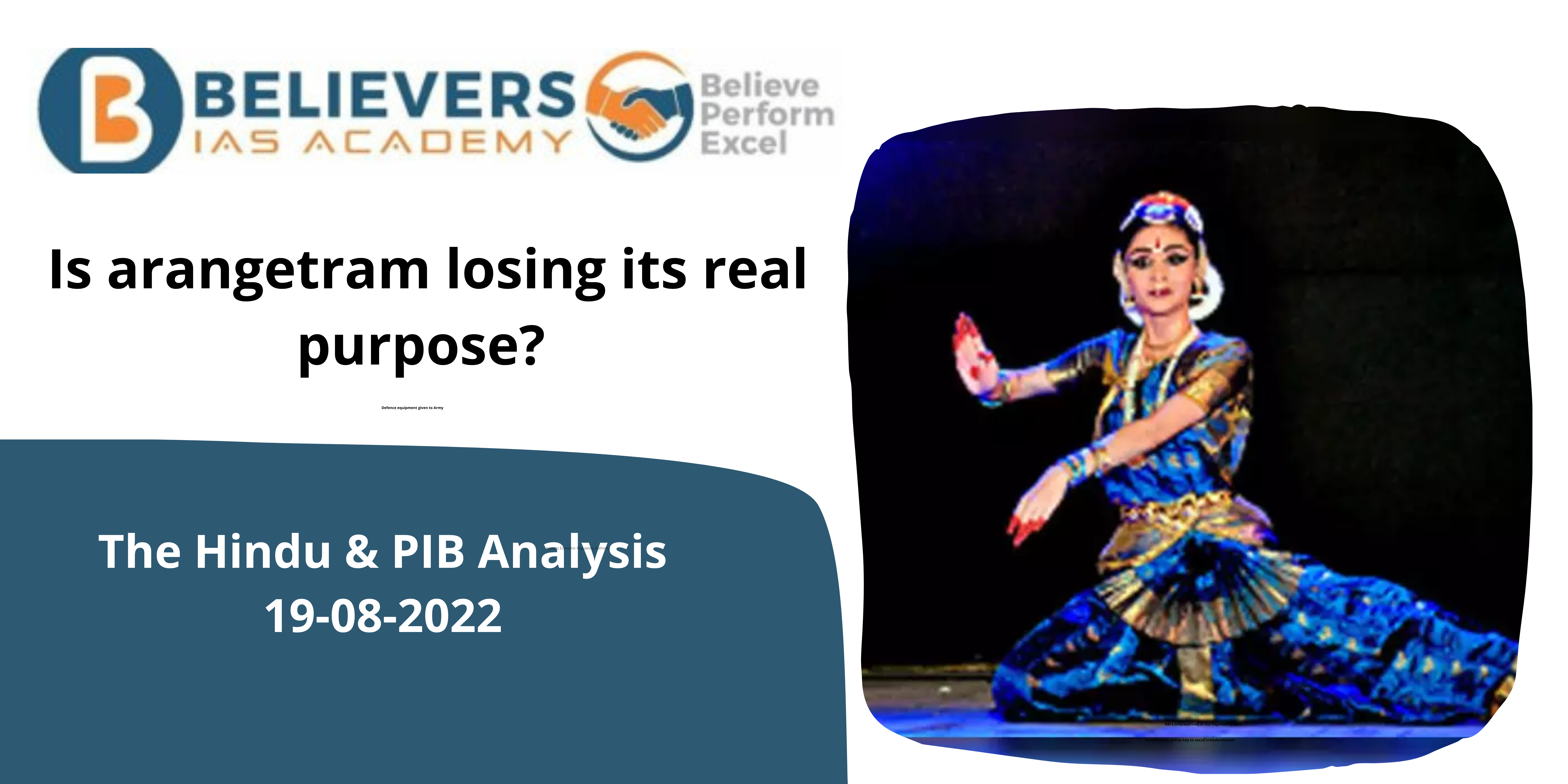Is arangetram losing its real purpose?
For Prelims
About Arangetram:
- The word Arangetram comes from the Tamil words ‘arangu’ meaning stage, and ‘etram’ meaning to climb.
- One of the early references to the ceremony dates back to approximately the 5th century AD Tamil text, Silappadikaram.
- It began as the formal ceremony where dancers would debut their craft in front of the king, where he would bestow his favourite dancer with a title and riches from the crown.
- The ceremony was not only an evaluation of the dancer’s skill and training, but also of her poise, showmanship and ability to dress the part.
Classical Dances in India
- The Sangeet Natak Academy recognizes eight dance forms as classical dances of India.
For Mains
Classical Dances and their features:
Bharatanatyam, Kathak, Kathakali, Kuchipudi, Manipuri, Mohiniyattam, Odissi and Sattriya.
- Bharatanatyam: Bharatanatyam originated in Tamil Nadu and grew out of the art of dancers dedicated to temples, and was earlier known as Sadir or Dasi Attam. Bharatanatyam rests on principles of performance and an aesthetics set down in classics such as Bharata’s Natyashastra.
- Kathak: Kathak is the principal dance of northern India, and is widely practised in Uttar Pradesh, Rajasthan, Delhi, Madhya Pradesh, and even parts of western and eastern India today. Kathak is characterized stylistically by its footwork and pirouettes, and is pre-eminently a dance of rhythm-play.
- Kathakali: Kathakali or ‘story play’ took shape in Kerala in the seventeenth century. Stories from the Ramayana and Mahabharata provide the content of most Kathakali plays. The faces of actors are painted according to the type of character they represent – green for heroes, kings, and divinities, red and black for the evil and fierce, etc.
- Kuchipudi: Kuchipudi, one of the major dance forms of India originated from Andhra Pradesh, where it grew largely as a product of Bhakti movement beginning in the 7th Century AD. Kuchipudi derives its name from the village Kuchelapuram. Kuchipudi, combines speech, Abhinaya (mime) and pure dance. Kuchipudi dance is accompanied by Carnatic Music. Kuchipudi today is performed either as a solo, duet or a group presentation, but historically it was performed as a dance drama, with several dancers taking different roles.
- Manipuri: Manipuri dance, evolved in Manipur in north-eastern India, is anchored in the Vaishnava faith of the Meiteis. The predominant theme of Manipuri dance is devotion, and the rich lore of Radha and Krishna lends it episodic content. Jagoi and cholom are the two main divisions in Manipur’s dance, the one gentle and the other vigorous, corresponding to the lasya and tandava elements described in Sanskrit literature.
- Mohiniyattam: Mohiniattam, which belongs to Kerala, takes its name from the mythic enchantress Mohini. It is a dance of feminine grace, and has grown out of performances connected with Kerala’s temples. Characterized as it is by femininity, Mohiniattam has no heavy steps or rhythmic tension: the footwork is gentle, soft, and sliding. The dancer’s body rises and falls with an easy grace, with the emphasis mainly on the torso.
- Odissi: Odissi dance has its origins in Orissa in eastern India, where in its rudimentary form it was performed as part of temple service by ‘maharis’ or female temple servants. The Vaishnava faith of Orissa is intrinsic to Odissi dance and the lore of Krishna and Radha supplies its content. Love lyrics from Jayadeva’s Sanskrit work Gitagovindam therefore have pride of place on the Odissi dance repertoire, together with songs in Oriya by medieval and early modern poets such as Upendra Bhanja and Banamali Das.
- Sattriya: Sattriya dance’ refers to the body of dance and danced drama developed in the sattras or monasteries of Assam since the sixteenth century, when the Vaishnava faith propagated by the saint and reformer Shankaradeva (1449-1586) swept the land. It is a distinct genre within the fold of classical Indian dance, with an evolved language of hand gesture (hasta), footwork (pada karma), movement and expression (Nritta and Abhinaya), and a repertoire centered on devotion to Krishna.
Source: THE HINDU




